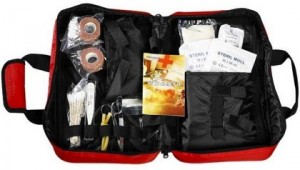Undergraduate perspective on Sports & Exercise Medicine – a BJSM blog series
By David Eastwood (@Eastyy)

The Doctor’s Kitbag
A recent student selected component in my studies allowed me to shadow the club doctor of Sunderland AFC, a Premier League football team. I gained an insight into the role of a football doctor, seeing the typical illnesses and injuries doctor’s face on a daily basis, and what medications are carried into combat with them.
Interestingly, there are no current regulations specifying what drugs a pitch-side Doctor should carry with them. A US Consensus statement published in 20011 categorises that it is essential for a team physician to carry medications that cover anaphylaxis, asthma, sudden cardiac arrest, heat illness and spinal cord injury. It goes on to state that it is desirable to carry medications to cover soft tissue injuries, dislocation, fractures, lacerations, eye and dental injuries. However, as far as the UK is concerned there are no similar documents in place.
What’s Inside?
After a discussion with the club doctor, it became clear that the choice of medications came down to personal preference and past experiences. I wanted to delve into this – six teams, including Sunderland, were kind enough to reply with a list of the medications that they choose to carry.
The literature shows that professional football players consume a considerable quantity of medication, especially non-steroidal anti-inflammatories, prior to competition.2 But what else are they actually taking?
Clearly some drugs are essential. The very nature of impact sports means that musculoskeletal injuries are extremely common. Therefore, adequate pain relief via non-steroidal anti-inflammatories, simple pain killers and even opiates are all things that should be found in the (good) doctor’s kit bag.
Physiological changes in athletes such as alterations in gut motility, enteric nervous system activity and circulating gut hormone levels predispose to a variety of gastrointestinal disorders.3 Therefore, a range of anti-diarroheals, anti-emetics and anti-reflux drugs were included in the bags.
Coverage for acute emergencies is also fundamental. Cardiac drugs for concerns over sudden cardiac death, insulin and glucagon for diabetic emergencies, salbutamol and steroids for asthma attacks and an epipen for allergic reactions all provide sensible insurance. Learning from such episodes as the Fabrice Muamba situation, the doctor must adopt the ‘fail to prepare, prepare to fail” mantra when it comes to acute emergency medications and equipment (defib etc.).
Some items are a little more diverse. With stressed coaching staff in mind, one doctor said he now carries GTN spray with him. A wide range of antibiotic cover is needed for the diverse range of infections that both the athletes and staff are susceptible to: ear infections, strep throat, meningitis, sinusitis. Don’t forget sexually transmitted infections as athletes are often less forthcoming with this information!
Students should be aware your bag will vary according to your athletes – many need very specific treatments. My research turned up for instance, that Anusol, an ointment used to treat haemorrhoids, and quinine sulphate, used in some individuals for leg cramps, were carried by some doctors. Think outside the box. (A word of caution about quinine – there is a risk of blood dyscrasias so use with care!).
What does this mean?
Catering for a group of players with diverse medical histories and diverse individual requirements means a club doctor needs to take a very general approach to drug selection. There is considerable overlap between clubs with respect to what drugs each club doctor chooses to carry, especially for emergencies, but individual specific treatment often dictates the rest of the content. Remember it is a bag not a suitcase – Don’t carry things that you will never use and will just run out of date. Therein lies the biggest take home message for students during their first few years of training – we might not be the ones choosing the meds in the bag, but we can at least help by checking it is all in date!
Conclusion
Should some regulations be put in place? Ultimately, it is the doctor’s responsibility to be suitably prepared for any pitch side scenario but some guidance would be useful in providing a framework. As a undergraduate or newly qualified student you mind find yourself in the situation where you are carrying the medical bag, just make sure you know what is inside and more importantly what isn’t!
References
1) http://www.aaos.org/about/papers/advistmt/1022.asp
2) P Tscholl, A Junge, J Dvorak. The use of medication and nutritional supplements during FIFA world cups 2002 and 2006.
3) ter Steege RW, Kolkman JJ. Review article: the pathophysiology and management of gastrointestinal symptoms during physical exercise, and the role of splanchnic blood flow. Aliment PharmacolTher 35:516. (2012)
******************************************
David Eastwood is a final year medical undergraduate student at Newcastle University, UK. He is cofounder of the Newcastle Sport & Exercise Medicine Society (NSEMS) and has articles published in the Student British Medical Journal conveying his passion for SEM.
Liam West BSc (Hons) is a final year medical undergraduate student at Cardiff University, Wales. He coordinates the “Undergraduate Perspective on Sports & Exercise Medicine” Blog Series for BJSM.